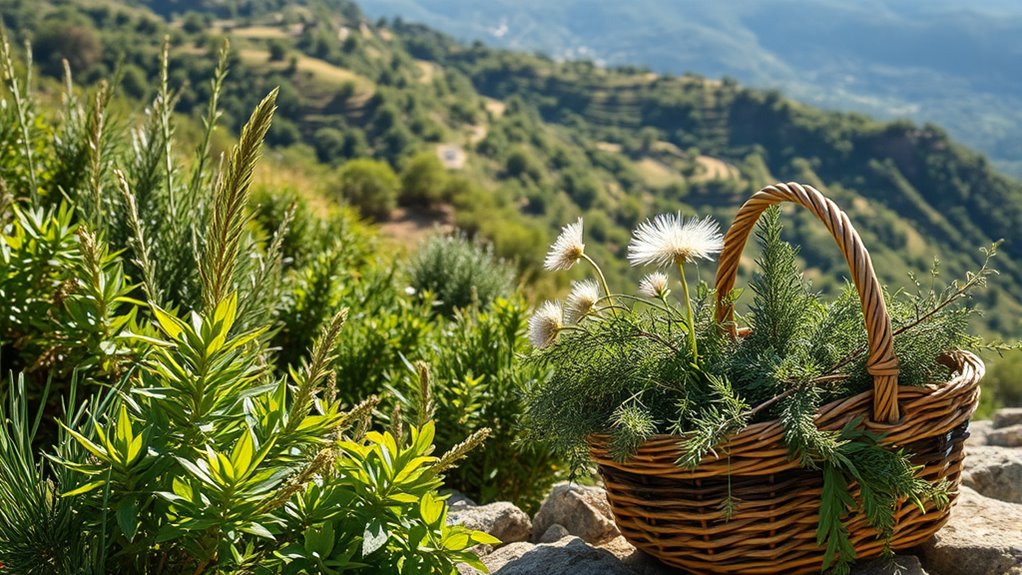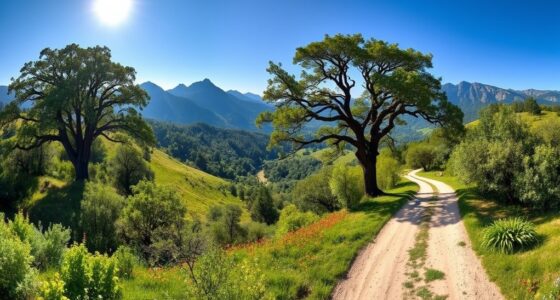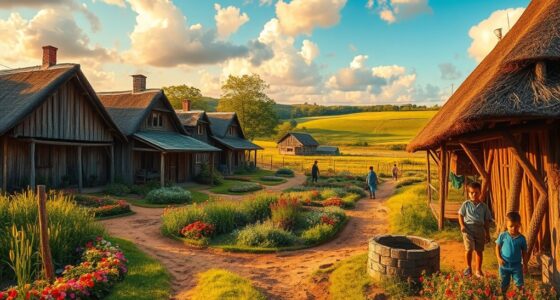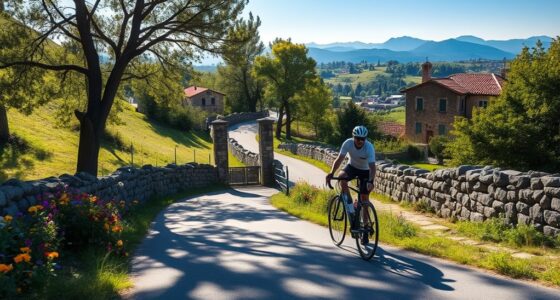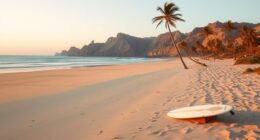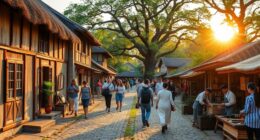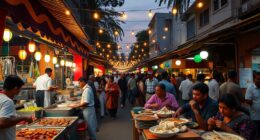In Sardinia, wild herb foraging offers a wonderful way to connect with the island’s rich biodiversity and traditional culture. You can find herbs like wild fennel, thyme, rosemary, and myrtle growing in various habitats, especially in spring and summer. By mastering safe collection techniques, you’ll enjoy flavorful culinary creations and discover their medicinal benefits. Keep exploring to uncover how seasonal foraging can deepen your appreciation of Sardinia’s natural treasures.
Key Takeaways
- Sardinia offers diverse habitats ideal for foraging wild herbs like wild fennel, thyme, rosemary, and myrtle, especially in spring and summer.
- Proper botanical identification and local guidance are essential for safe, sustainable harvesting of edible wild herbs.
- Seasonal timing, such as just before flowering or during peak growth, ensures optimal flavor and medicinal benefits.
- Wild herbs are traditionally used in Sardinian cuisine and herbal medicine for flavoring, digestion, and respiratory health.
- Sustainable foraging practices include selective harvesting, respecting growth cycles, and avoiding pollution to preserve plant populations.
The Rich Diversity of Sardinian Flora
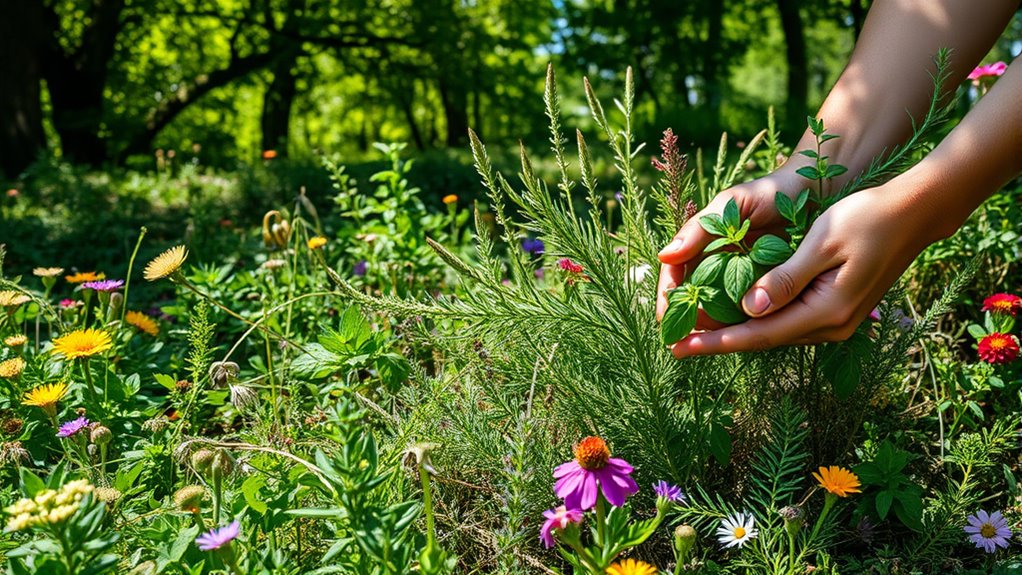
Sardinia’s unique geography and long-standing isolation foster an incredibly rich diversity of plants. You’ll find about 341 endemic vascular plant taxa here, making up roughly 13–15% of the island’s native flora. Sardinia is part of the Tyrrhenian Islands macro-hotspot, a key Mediterranean biodiversity hotspot, which explains its high endemism. The island hosts both ancient paleoendemics and recently evolved neoendemics, highlighting its complex evolutionary history. Around 168–180 exclusive Sardinian endemics include species, subspecies, and hybrids, showcasing the island’s unique botanical heritage. Its varied landscapes—from mountains to coastal areas—create diverse habitats that support this remarkable flora. This diversity reflects Sardinia’s geographic isolation, fostering speciation and preservation of rare plant species found nowhere else in the world. The island’s protected status and conservation efforts play a crucial role in maintaining this extraordinary botanical richness. Additionally, the presence of endemic plant species underscores the importance of ongoing conservation initiatives to safeguard Sardinia’s unique flora.
Traditional Uses of Wild Herbs in Sardinia
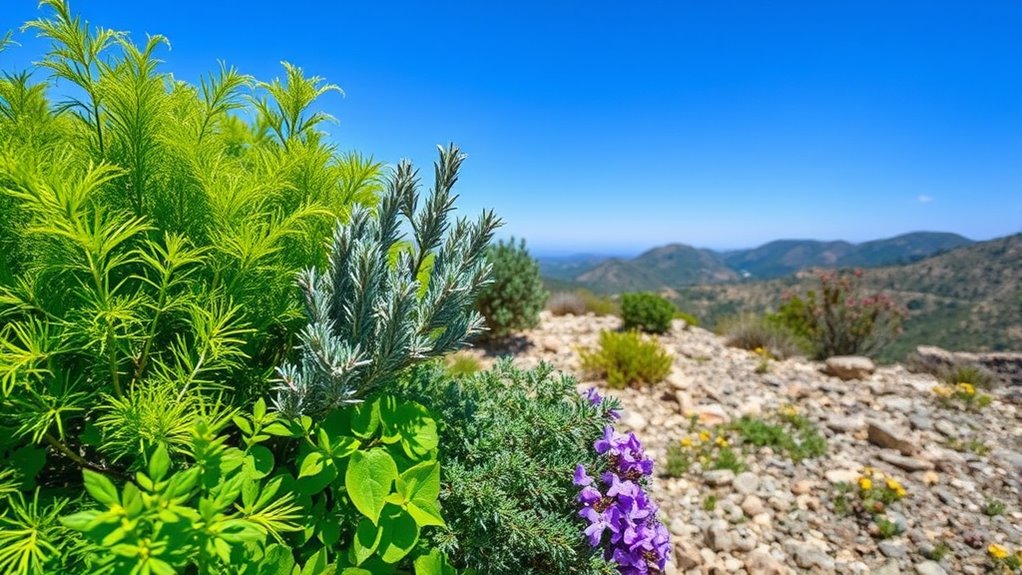
The island’s rich botanical diversity has shaped a long-standing tradition of utilizing wild herbs for both culinary and medicinal purposes. You might use myrtle to soothe respiratory issues, drinking teas made from its leaves and flowers. Wild fennel is your go-to for digestion, often added to meals or brewed as a tea. Lavender helps calm nerves and reduce anxiety, while sage treats inflammation both internally and topically. Chamomile is your mild sedative, aiding sleep with a simple tea. Traditional Sardinian preparation mainly involves decoctions, infusions, and topical applications, depending on the herb. These plants are deeply woven into local culture, used to address digestive, nervous, skin, and respiratory conditions with a practical, holistic approach. Additionally, the medicinal properties of these herbs have been passed down through generations, maintaining their importance in local health practices.
Seasonal Foraging: When and What to Collect
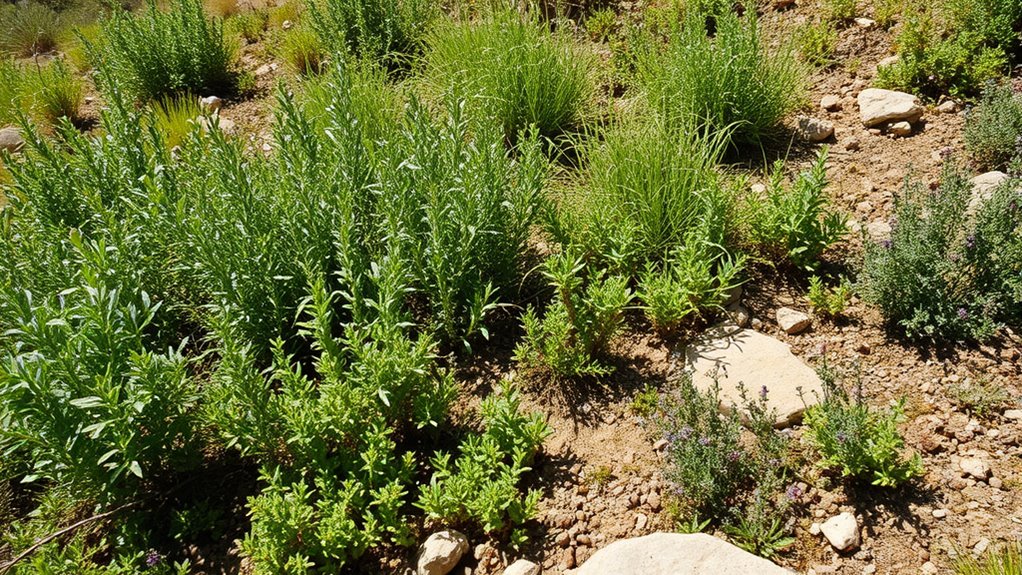
Knowing when to forage guarantees you pick herbs at their peak flavor and potency. Spring offers wild garlic, asparagus, and chicory, while summer is perfect for oregano and mountain herbs. By understanding seasonal patterns, you can harvest the right plants at the right time for delicious and sustainable gathering. Seasonal knowledge helps ensure sustainable harvesting practices, allowing nature to replenish and thrive for future foragers. Additionally, being aware of noise levels of modern heat pumps can contribute to maintaining a peaceful environment in your home, especially when installing new systems.
Optimal Harvest Seasons
Spring emerges as the prime season for wild herb foraging in Sardinia, offering an abundance of fresh greens and edible plants. During this time, you should focus on young shoots like wild asparagus, which are best harvested early spring when tender and flavorful. Spring rains trigger vigorous growth, making it ideal for gathering a variety of herbs and greens before they flower. To maximize flavor and potency, pick herbs just before they bloom, especially wild oregano and thyme. Summer, before flowering, is perfect for collecting wild oregano, while late summer to early autumn is ideal for aromatic herbs like rosemary and thyme, when their oils are at their peak. Keep in mind that Sardinia’s climate and microclimates influence these timings, so observing local conditions is key. Wild asparagus can be large and fat, especially when in coupling, highlighting the importance of harvesting at the right time for optimal taste. Additionally, climate variations can significantly affect the growth cycles of wild herbs, so local knowledge enhances foraging success.
Key Edible Wild Plants
Seasonal foraging in Sardinia offers a rich array of edible wild plants that vary throughout the year, so knowing when to harvest each is crucial for flavor and safety. Here are some key plants to watch for:
- Wild fennel: Pick tender shoots in late spring for salads and soups, and dry stems for year-round use. Wild fennel flowers can also be harvested in late spring for culinary and medicinal purposes, adding to the plant’s versatility. Its aromatic qualities make it a staple in traditional Sardinian cuisine, highlighting the importance of understanding local flora.
- Wild thyme: Harvest leaves in summer to season bread, fish, and meat dishes.
- Elderflowers and berries: Collect flowers in late spring and berries in late summer for infusions, desserts, and breads.
- Wild chicory: Gather leaves in spring and early summer for salads or cooking, offering a slightly bitter Mediterranean flavor. Being aware of seasonal harvesting ensures you gather at the optimal time for taste and nutritional value.
Commonly Foraged Wild Herbs and Their Benefits
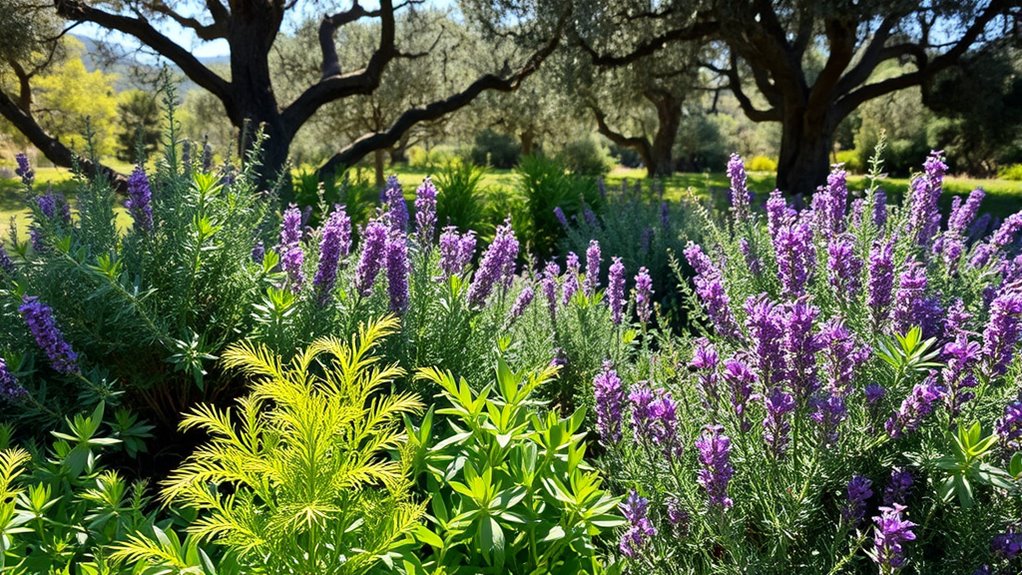
You’ll find Sardinia’s wild herbs bursting with flavor and health benefits, from fragrant rosemary to potent wild garlic. These key herbs offer healing properties, like anti-inflammatory and antimicrobial effects, and are staples in local cuisine. Exploring their culinary uses reveals how they enhance dishes and support wellness naturally. Incorporating these herbs into your diet can also promote environmental sustainability by utilizing locally sourced ingredients that reduce transportation emissions.
Key Sardinian Herbs
Sardinia’s diverse landscapes teem with wild herbs that are both culinary treasures and natural remedies. These key herbs are abundant and easy to forage, offering health benefits and rich flavors. The land’s natural beauty and the ecosystems supporting these plants have remained largely unchanged for centuries, ensuring the herbs’ potency and sustainability. Supporting ecosystems are crucial for maintaining the availability and health-promoting qualities of these wild herbs. 1. Rosemary: Aromatic and flavorful, it enhances meats and vegetables while providing antioxidant benefits. 2. Thyme: Thrives in Sardinia’s climate; used in cooking and known for anti-inflammatory properties. 3. Myrtle: With purple berries and leaves, it’s prized for antioxidants and making the traditional Mirto liqueur. 4. Wild fennel: Adds subtle anise flavor to dishes and contains vitamins and minerals that promote health. These herbs grow in various habitats like woodlands, rocky walls, and uncultivated fields, making foraging both rewarding and accessible.
Healing Properties Overview
Wild herbs thriving across Sardinia not only add flavor to local cuisine but also pack potent healing properties. Many have anti-inflammatory effects that can help reduce inflammation-related conditions. For example, thyme and helichrysum contain strong antioxidant actions, neutralizing free radicals and supporting overall wellness. Essential oils from juniper serve as anti-inflammatory and analgesic agents, easing joint pain and headaches. Myrtle, rich in tannins, provides astringent and antibacterial effects that support respiratory health. These herbs are often used in traditional remedies to boost the immune system and promote healing. Myrtle leaves and flowers are brewed as teas to relieve bronchial issues, while thyme infusions ease coughs. Juniper oils help clear airways, emphasizing their role in Sardinian natural medicine. Herbal practices are deeply embedded in Sardinian culture, with many families passing down these traditional healing methods through generations. The bioactive compounds in these herbs contribute significantly to their healing properties, making them valuable in natural therapies.
Culinary Uses
Have you ever wondered how foraged herbs enhance Sardinian cuisine? These wild herbs add depth, aroma, and health benefits to traditional dishes. Here’s what you can do with them:
- Use rosemary and myrtle to season roasted meats, infusing rich, piney scents.
- Add wild fennel to soups and salads for a sweet, anise-like flavor and digestive boost. Wild herbs contain bioactive compounds that support overall health.
- Incorporate thyme and oregano in seafood and pasta sauces for earthy, herbal notes.
- Mix nettles and mallow flowers into salads or brew as infusions, providing nutrients and vibrant color.
Techniques for Safe and Sustainable Foraging
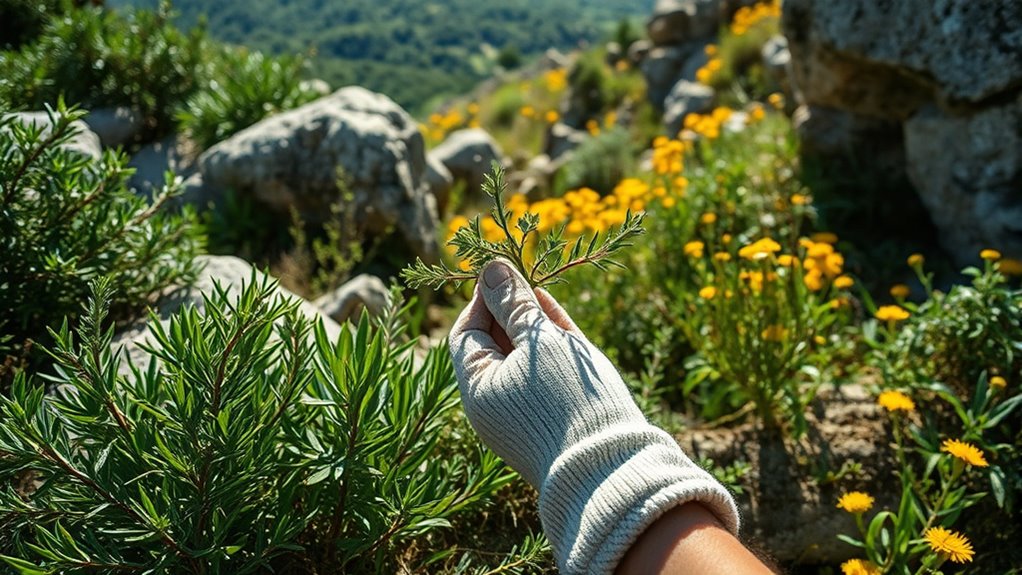
To forage safely and sustainably, you need to master botanical identification techniques that distinguish edible herbs from toxic lookalikes, especially in Sardinia’s diverse flora. Use local guides or attend botanical workshops to learn herb characteristics, ideal harvest seasons, and safe collection zones. Recognize growth patterns and habitats—like rosemary on rocky slopes or myrtle in shrublands—to target resources responsibly. Proper tire pressure and seasonal timing can influence the health of plants and the sustainability of foraging practices. Always confirm species identification before harvesting, and avoid plants near agricultural areas or pollution. Harvest only what you need, taking leaves, flowers, or stems, not uprooting entire plants, to ensure future growth. Rotate foraging sites to prevent overexploitation, and use natural-fiber baskets to allow seed dispersal. Properly clean herbs before use, and respect local customs and regulations, ensuring your foraging is both safe and eco-friendly. Botanical identification skills are essential for sustainable harvesting, which helps maintain the health of Sardinia’s diverse ecosystems.
Culinary Adventures With Sardinian Wild Herbs

Sardinian cuisine is renowned for its vibrant use of wild herbs, which add distinctive flavors and aromatic depth to traditional dishes. When cooking with these herbs, you can elevate simple ingredients into memorable meals. Here are some ways to bring wild herbs into your kitchen:
- Use wild fennel to create zesty salads or flavor fish dishes with an anise-like punch.
- Incorporate rosemary into roasted meats and potatoes for a piney aroma that enhances every bite.
- Add myrtle to meats or craft liqueurs that capture Sardinia’s aromatic bitterness.
- Mix sage into bean dishes or stuffing for earthy notes that deepen flavors.
Experimenting with these herbs not only boosts taste but also introduces authentic Sardinian character into your cooking.
Healing Properties and Herbal Remedies

Wild herbs possess remarkable healing properties that have been valued for centuries, blending natural remedies with daily life. You can use myrtle to ease respiratory issues, thanks to its antiseptic and astringent effects. Fennel helps digestion and reduces inflammation, making it a versatile remedy. Lavender is your go-to for anxiety, promoting emotional well-being, while sage offers anti-inflammatory benefits for various ailments. Chamomile acts as a sleep aid, helping you relax after a long day. Traditional remedies include helichrysum for skin problems and sunburns, thyme for coughs and digestion, and mastic with antioxidant and antibacterial properties. Juniper and rosemary support skin health and cognitive function. These herbs can be prepared as infusions, decoctions, or oils, seamlessly integrating healing into your everyday life. In Sardinia, these herbs have been used for centuries, reflecting a deep-rooted tradition of herbal medicine that continues today. Additionally, understanding herbal medicinal practices can enrich your appreciation for regional traditions and their therapeutic benefits.
Guided Foraging Tours and Educational Workshops
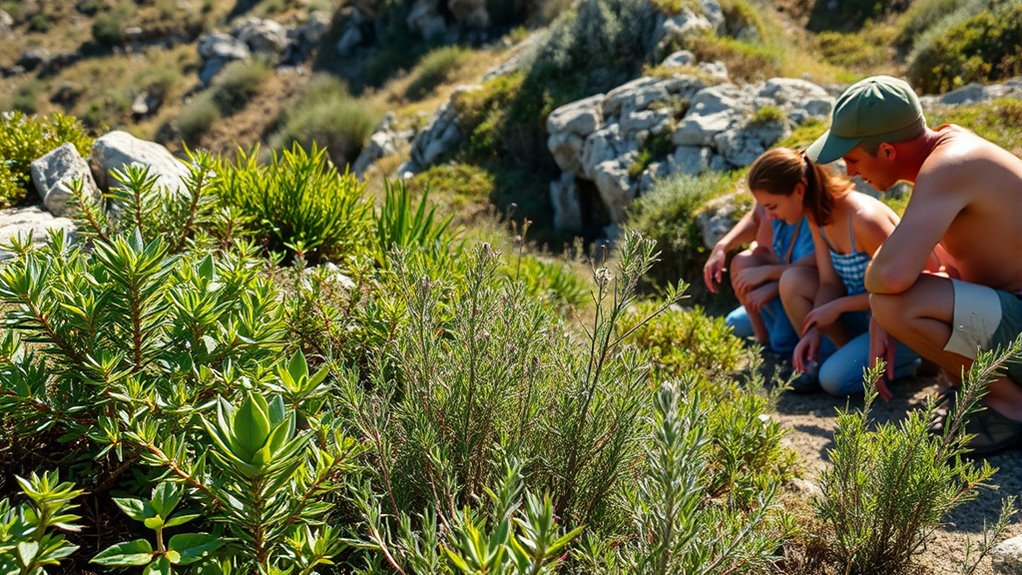
Guided foraging tours in Sardinia offer an immersive experience led by local herbalists with decades of knowledge in traditional folk medicine. You’ll explore scenic landscapes, learning to identify native wild herbs like wild lavender, thyme, and rosemary. During the tour, you’ll:
- Engage in hands-on herb gathering, practicing sustainable harvesting techniques.
- Hear stories about Sardinian traditions, rituals, and historical uses of herbs.
- Observe the diverse biomes that support the island’s rich plant life.
- Develop confidence in recognizing and collecting local herbs responsibly. The tours are designed to be accessible for most fitness levels, ensuring a comfortable experience for all participants. These tours blend nature walks with direct plant interaction, deepening your appreciation for Sardinia’s biodiversity. Suitable for beginners, they provide practical skills and cultural insights, making your herbal journey authentic and memorable.
Connecting With Sardinia’S Land Through Foraging
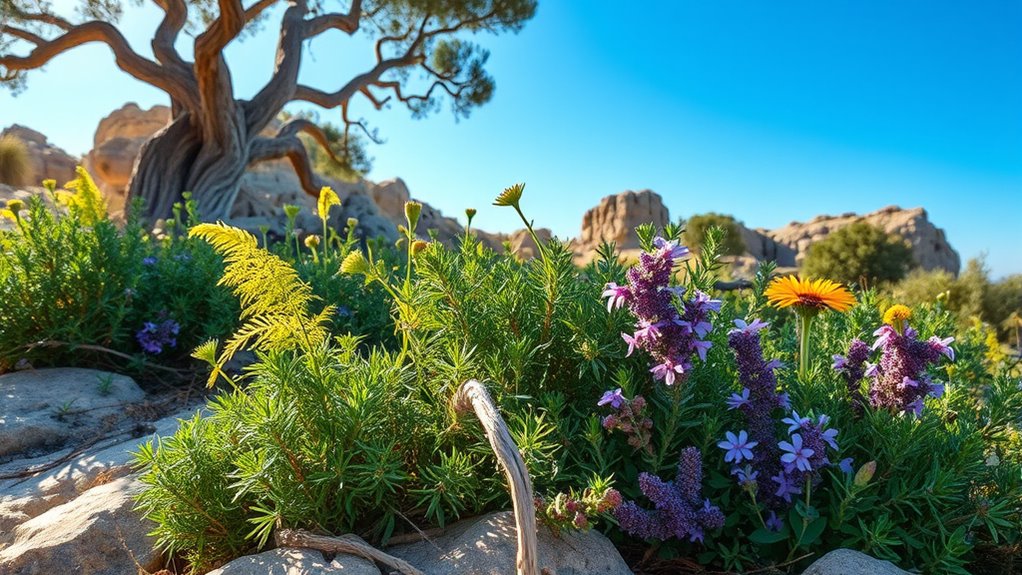
Connecting with Sardinia’s land through foraging allows you to experience a profound bond with the island’s natural environment. As you gather wild herbs like myrtle, fennel, thyme, and chamomile, you engage directly with Sardinia’s landscapes, appreciating their rich history and cultural significance. These plants have been used for centuries in traditional healing and culinary practices, linking you to generations past. Seasonal foraging teaches patience and respect for nature’s cycles, while sustainable harvesting preserves the land’s bounty. By identifying and collecting herbs responsibly, you deepen your connection to local heritage and natural rhythms. This hands-on experience fosters mindfulness, allowing you to feel more rooted in Sardinia’s unique environment and appreciate its enduring relationship with the land’s natural remedies. Myrtle, known since ancient times for its sweetly scented flowers with golden stamens and dark green shiny leaves and stalks, has been used for ornamental, culinary, and therapeutic purposes since the Middle Ages.
Frequently Asked Questions
Are There Any Legal Restrictions on Wild Herb Foraging in Sardinia?
You wonder if there are legal restrictions on wild herb foraging in Sardinia. Currently, there are no specific regional laws or regulations that directly restrict harvesting wild herbs, making it a widely accepted and traditional activity. However, you should be aware of local ordinances, especially when collecting near protected areas or for commercial purposes. Always respect environmental guidelines and avoid endangered species to stay within legal boundaries.
How Can Beginners Identify Edible Versus Toxic Wild Herbs?
You might worry about confusing safe herbs with toxic ones, but with careful observation, you can distinguish them. Focus on sensory traits like smell, leaf shape, and color. Edible herbs often have pleasant aromas and vibrant green leaves, while toxic plants may smell bitter or pungent and look unusual. Use local guides, photos, and traditional knowledge to build confidence, and always test small amounts before full consumption.
What Equipment Is Recommended for Sustainable Foraging Practices?
You should carry tools like Felco pruners and sharp knives for precise harvesting, ensuring clean cuts that help plants recover. Use breathable mesh or paper bags to transport herbs, preventing moisture buildup. Bring a field guide or smartphone app to identify plants correctly and avoid overharvesting endangered species. Wear gloves to protect yourself and follow sustainable practices like leaving enough plant material, ensuring the ecosystem stays healthy for future foraging.
Can Wild Herbs Be Harvested Sustainably Without Damaging Local Ecosystems?
Imagine you’re harvesting wild herbs responsibly, like a local Sardinian farmer who uses selective leaf harvesting during peak growth. You can do this sustainably by avoiding uprooting plants, respecting seasonal limits, and using traditional ecological knowledge. This approach guarantees plants can regenerate, preserves biodiversity, and minimizes ecosystem disruption. By practicing mindful foraging, you contribute to maintaining healthy ecosystems while enjoying the benefits of wild herbs.
Are There Specific Safety Tips for Foraging in Sardinian Mountain Areas?
When foraging in Sardinian mountain areas, you should prioritize safety by wearing sturdy shoes, carrying plenty of water, and using sun protection. Stay on established paths, inform someone of your plans, and check local regulations to avoid protected zones. Be vigilant for wildlife like snakes and insects, and always identify herbs accurately with guides or experts. Avoid foraging in bad weather and wash herbs thoroughly before use.
Conclusion
Exploring Sardinia’s wild herbs offers a rewarding glimpse into its rich landscape. As the saying goes, “You reap what you sow,” so approach foraging with respect and mindfulness. By learning about seasonal herbs, safe techniques, and culinary uses, you connect deeply with the land’s natural bounty. Embrace the adventure, stay curious, and cherish every discovery—because the more you explore, the more Sardinia’s vibrant flora will reward you.
